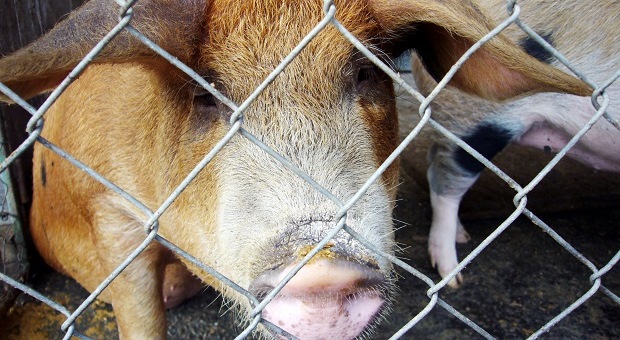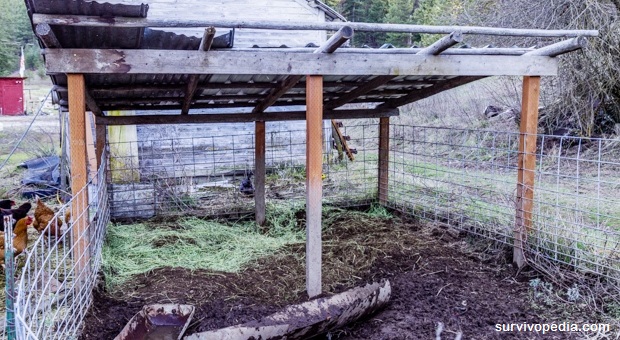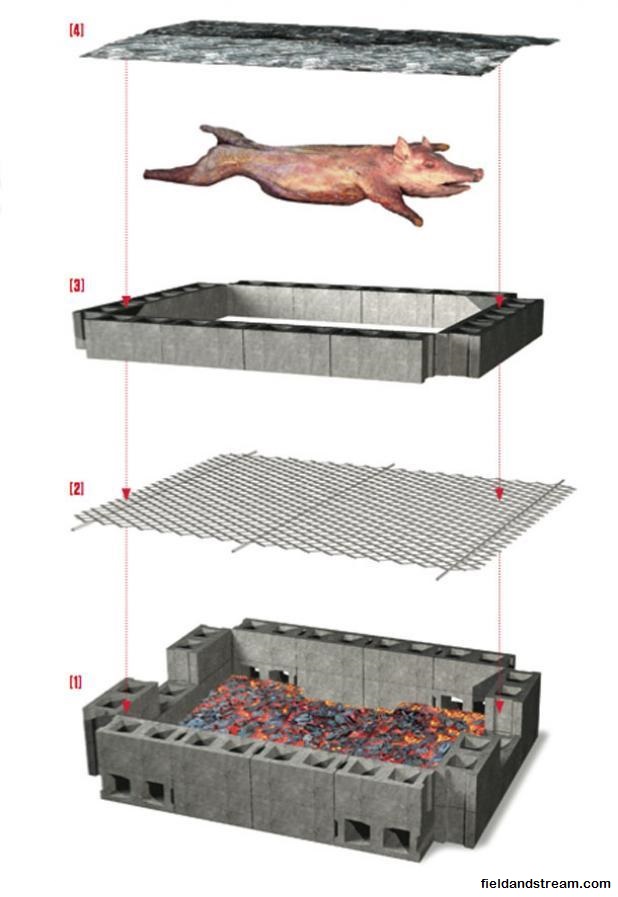Have you noticed the price of bacon lately? How about pork chops? Pork prices are soaring.
Besides costing an arm and a leg, grocery store pork often contains questionable ingredients. Things like benzoate preservatives and ractopamine. Ew! I like to be able to pronounce the ingredients I eat.
Thankfully, there’s at least one solution.
Raising your own hogs will help lower the price point per pound. It’ll also give you complete control over what goes into your meat. Hogs aren’t only beneficial in today’s market. When the SHTF, they’ll be invaluable. They’re the perfect homesteading addition as you prepare for the future. Ready to get started?
Here’s what you need to know before bringing home the bacon.
3 Important Considerations for Raising Hogs
Before bringing home any new animal, there’s a lot to think about. But there are some specifics just for hogs:
Do You Want to Breed Pigs or Just Raise Them Each Year?
There are two primary methods of pig raising. You can start each spring with a couple of little ones and butcher them in the fall. Or you can get your own breeding stock and raise pigs year round. There are benefits to each.
I’m currently buying weaner pigs each. My parents kept pigs year round when I was younger, and I enjoyed that. Someday I’ll winterize our pig pen and get breeding stock of my own.
Having your own stock will ensure your access to pork annually, which is preferred for survival. You may not always be able to find piglets to buy. Keeping pigs year round eliminates the search. However, year round hogs are the harder option. You’ll have to ensure your pig pen offers adequate protection for each season. Your feed costs will also be higher, as pregnant pigs eat a lot.
If you’ve never raised pigs before, consider starting off with just a couple of weaner pigs. Raising these to market weight will provide valuable knowledge and experience. Try this at least once before tackling your own hog-breeding program.
Cost of Pigs
Pigs used to be inexpensive animals. But now, $100 seems to be the new low for weaner pigs. During the spring, when everyone is buying, they’ll be much more.
Adult breeding stock costs more. Expect to pay several hundred for each sow and boar.
Since pigs enjoy the company of other pigs, you should raise at least two. If you don’t need the meat, you can always sell it.
What Will Your Pig Eat?
The easiest thing to feed your pig is a steady diet of hog chow. It’s formulated to meet your pigs’ needs, including the proper amount of protein and nutrients.
Hog chow is also the most expensive way to fatten up your hog. Each one will take a half ton by the time they reach butcher weight.
There are ways to lower your feed bill. You can give your pigs table scraps. These creatures eat just about anything.
Mine don’t like citrus or banana peels, onions, or raw potato peels, but eat everything else we feed them. We collect our produce scraps in a container in the kitchen, and feed them to the pigs once a day. They love it. We also feed ours extra milk from our cows, eggs that got cracked, or bruised apples. Pigs are a great way to reduce wasted food!
Just because a pig can eat almost everything, doesn’t mean you should feed them everything. They should never eat pork products, rotten foods, or highly sugared pastries. Remember that what you’re feeding them is turning into the meat you’re going to be eating.
To lower your feed costs even more, you can get creative. Are there any local cheese making companies that’d let you have whey? Or a small grocery store that’d give you unsold produce? Look around, and think creatively to obtain feed.
Water
Pigs drink a lot, so you’ll have to give them constant access to fresh water. While you can use a trough, your pigs will probably dump it out a couple of times each day. They like playing in it. To solve this problem, you can get an automatic waterer at most feed stores. These hook up to a hose, or to a bucket. The pigs drink through a nipple.
What Do You Need to Raise Pigs?
Hogs aren’t as needy as many other livestock. They don’t require as much infrastructure. They aren’t as picky on their feed. In addition to the feed and water mentioned earlier, your pigs will need the following:
Shade
Pigs need shade. They don’t sweat, and can easily overheat in the hot sun. Make sure they have shade.
If your pigs are on pasture, trees are one way to provide shade. If they’re in an outdoor pen, give them a roof or tarp. Indoors, make sure they have ventilation to keep the heat down.
Shelter
If you won’t be wintering your hogs, they won’t need a complicated shelter. Give them a place to get out of the wind and rain.
For cold climates, your pigs will need more protection. You can knock up a sturdy structure for them. That way they can bed down and stay warm.
Fencing
If your pigs will be outdoors, you’ll need a fence to keep them in. Pigs are notorious for testing fences and finding holes. Make sure yours are secure.
Common hog fences are made from hog panels or field fence. You can also train pigs to electric wire. To teach them, run an electric wire at snout level around the perimeter of a small pen.
While they’re learning, it’s best to have an additional fence up. That’ll teach the hogs to go backwards from the shock instead of running forward.
Inexpensive Pig Pen
It’s possible to provide everything your pig needs without spending a fortune. Here’s what our pig pen looks like:
We used four hog panels, but didn’t make it square. Instead, we curved one of the panels, increasing the square footage of the pen. We secured the panels to T-Posts we already had around the farm.
To provide both shelter and shade, we added a simple roof over part of the pen. We used wooden poles we made from trees on the property for the structure. Metal scraps left over from other projects topped it. We used treated posts to hold the roof up. If you have rot-resistant wood in your area, those are even cheaper.
To make my pen winter ready, I need to enclose the sides under the roof. That’d give the hogs a place to stay dry and warm. It’s on my someday list!
Farrowing Area (If Breeding)
A sow’s gestation lasts about 115 days. You’ll want to make sure she’s in her own area before giving birth. Make sure she has plenty of bedding.
You’ll need to check for stillborn piglets. Check in on your growing litter frequently at first. Inexperienced mama pigs can lie on their babies and squish them.
Why Would Anyone Choose Hogs Over Other Animals for Survival?
When times are tough, you need an animal that is low maintenance. You need one that gives you the most value for your money and time. You need a hog.
It’s true that you can use everything but the squeal. Hogs give you tasty meat, fat for lard, and fertilizer for your vegetables.
Hogs also require a low time commitment. Once you’ve gotten their fence and shelter up, you just need to feed, water, and add bedding as needed. They are low maintenance, except during the farrowing season.
The hogs will also eat your food scraps, helping to keep your waste piles small. In a crisis, trash can easily pile up. Pigs will ensure there’s no food scraps going to waste.
Hogs don’t require as much space as larger animals, so they’ll be easier to keep in smaller quarters. Their snouts are great at tilling the ground and can prep your garden. They’re very versatile animals on the homestead.
Other Essentials About Raising Hogs
Because they’re constantly rooting around, hogs are prone to intestinal parasites. Some farmers routinely worm. You’ll want to check with a vet to find the recommended wormer for your area.
Many farmers castrate their male hogs, especially if they’re running males and females together. A castrated male is known as a barrow. Uncastrated males, known as boars, produce meat with a different flavor. It’s known as boar taint. They’re also more likely to be aggressive.
Ideal Butcher Size
Most pig farmers and homesteaders raise pigs to 225-250 pounds. It’s considered the perfect market size. Any bigger, and your feeding costs go up and you’ll get more fat.
Historically, pigs were bigger at butchering time. That’s because pioneers depended on lard for cooking, making soap, and plenty of other tasks. They needed fat pigs because they used the fat. If current economic conditions continue to change, you might see the return of the extra big pig.
Don’t worry though. You won’t have to drag a scale out to the pigpen. You can calculate a pig’s weight based on some simple measurements. All you’ll need is a piece of string, a measuring stick, and some time. It really works! It’s how I determine when it’s time to butcher.
Butchering
When your hog reaches market size, you’ll need to make butchering arrangements. Since pigs are smaller than cows, many homesteaders handle this part on their own. I don’t. I call our local butcher, and they send someone out to the farm. The pigs are dispatched here, while I watch and learn all I can. Maybe someday I’ll try it myself. After dressing, they’re hauled in a refrigerated truck to get processed. The facility also smokes the meat for me.
If you decide to butcher on your own, this field dressing guide will help. Pigs are covered in hair, which you can either singe or scrape off. Skinning is also an option.
After you dress the pig, hanging for a few days will improve the flavor. The cool days of fall are perfect for butchering. Then, you can proceed to cut and wrap your pork.
How to Make Money From Raising Hogs
Pigs can be profitable! If you’re hoping to make money from raising hogs, you have several options. You can invest in quality breeding stock, and sell piglets for show. These typically sell for more than piglets for the table. 4H students are prospective buyers.
If you aren’t raising show hogs, consider selling them at a variety of sizes. Weaners are small pigs, around 25 pounds. They’ve just been weaned and are ready for farmers or homesteaders to raise. You can also keep your piglets a little longer, and sell them as growers. Those weigh 40-70 pounds. Hogs weighing over 150 pounds are known as finishers. They require more time and feed on your part, but usually sell for more money.
In addition to selling live pigs for others to finish, you can sell market ready hogs. A typical pricing method is to sell at a price per pound, hanging weight. You can add the kill fee into your price per pound. Once the hanging pig arrives at the butcher, the buyer can have it cut to specifications. The buyer is then responsible for cutting and wrapping expenses.
When I raise spring pigs, I usually buy one extra to sell. It usually brings enough money to pay for the initial cost, feed, and butchering costs for both pigs. It also covers my cut and wrap expenses.
Alternatively, you can have the pig processed and then sell the meat. This requires additional legalities than selling them live.
Around here, I’d have to pass an on-site inspection to legally sell pigs this way. Then I’d have to use a specific butcher that’s been USDA approved for hogs. Your local requirements may vary, so be sure to research these before you start selling processed pork.
If you smoke your own bacon and ham, you have a value added product. Maybe you’ll discover a niche market for dry canned bacon. Just make sure to follow the laws in your location. In addition to selling your pigs for meat, you can use other by-products for profit. You can sell manure for gardeners. You can turn the ears into delicious dog treats. With a little creativity, your pigs can bring income to your farm.
Are you raising pigs for survival? Do you have any additional insight to share, or questions that still need answered? Please post them in the comments of this article.
More are still to come about the simple ways to food independence. CLICK on the banner below if you are willing to take your farming to the next level!
This article has been written by Lisa Tanner for Survivopedia.












david | March 31, 2016
|
a sow that’s has pigs out side or a say 12×12 pen in side a barn if no guard rails can lay on the pigs and not know it. that’s why crates are the best way to birthbaby pigs the percentage of pigs layed on is very small.
Jeff | March 31, 2016
|
The most gentle sows become vicious when dropping (birthing) piglets or working the piglets. If the piglets get excited and squeals be ready to take action. I had several sows turn on me during birth and while working the piglets. Separate the sow from the piglets when it comes to breaking tusk, ear notching and castrating.
DaveS | March 31, 2016
|
An old dairy farmer once told me why dairy farms always have a hog pen. “Hogs pay the mortgage.” Milk prices may be low or your cows may not be productive for part of the year. But you can always sell a hog or two and get some cash when you need it.
Mahatma Muhjesbude | March 31, 2016
|
Well written article, Lisa. Years ago when I got started in ‘prepping’ after the Y-2K jumpstart, I remember a type of smaller brown pig that was supposed to be an ideal extra animal at your compound to have in a rural environment?
I can’t find anything on it at the moment but i recall it was virtually self-reliant and if you just provided water and shelter at a spot you didn’t even have to fence them or feed them much in as they wandered around the land relatively close by in the forest foraging during the day and came back to their home base at night?
They weren’t very big, like not more than 100 pounds but they bred themselves if you started with a pair and could keep you in pork chops indefinately without the work time or maintenance of regular hogs?
But I never heard of or saw them again?
Rick | March 31, 2016
|
They are called Guinea Hogs.
Johnson | March 31, 2016
|
Inbred Hogs long scale long-term or not desirable. They usually come up with offspring that are deformed and are runted. Replace the boar every year or so. Boars do make pretty good sausage or trade some one. I eased hogs for years usually several hundred head. Find your breading boar make sure you get a boar with 6 nipple 8 is better. Sounds crazy have had some with 4 and never had large litters tell an old pig guy told me. Tryed it and darned if it didn’t work. What I used for Wenger pigs tell they get to big. Is old pic up toppers no one wanted put straw in and 25 little guys in and at 10 below the heat would be rolling out of it. Sun coming in the windows heats it up with the body heat.
Leslie Fish | March 31, 2016
|
Another value of raising hogs, especially if you free-range them visibly on your property: Islamist terrorists will avoid your land like the plague. They have a religious horror of pigs, and consider any ground that hogs might have peed upon as ritually unclean. They might shoot at the hogs from a distance, but they won’t come near the land they’ve walked on.
Pingback:10 Breeds Of Hogs To Choose From For Survival | Survivopedia | April 1, 2016
|
Pingback:10 Breeds Of Hogs To Choose From For Survival | Prepper's Survival Homestead | April 1, 2016
|
Pingback:10 Breeds Of Hogs To Choose From For Survival | | disasterdefense.us | April 2, 2016
|